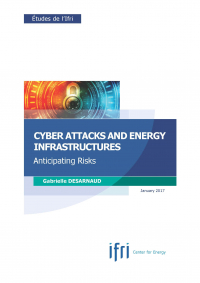Gateway to Think Tanks
| 来源类型 | Publications - Reports |
| 规范类型 | 报告 |
| Cyber Attacks and Energy Infrastructures: Anticipating Risks Etudes de l'Ifri, January 2017 | |
| Gabrielle DESARNAUD | |
| 发表日期 | 2017-01-31 |
| 出版年 | 2017 |
| 概述 | This study analyses the likelihood of cyber attacks against European energy infrastructures and their potential consequences, particularly on the electricity grid. It also delivers a comparative analysis of measures taken by different European countries to protect their industries and... |
| 摘要 |
Cyber Attacks and Energy Infrastructures: Anticipating Risks Etudes de l'Ifri, January 2017
This study analyses the likelihood of cyber attacks against European energy infrastructures and their potential consequences, particularly on the electricity grid. It also delivers a comparative analysis of measures taken by different European countries to protect their industries and collaborate within the European Union.  The energy sector experiences an unprecedented digital transformation upsetting its activities and business models. Our energy infrastructures, sometimes more than a decade old and designed to remain functional for many years to come, now constantly interact with light digital components. The convergence of the global industrial system with the power of advanced computing and analytics reveals untapped opportunities at every step of the energy value chain. However, the introduction of digital elements in old and unprotected industrial equipments also exposes the energy industry to the cyber risk. One of the most compelling example of the type of threat the industry is facing, is the 2015 cyber attack on the Ukraine power grid, which deprived about 200 000 people of electricity in the middle of the winter. The number and the level of technical expertise of cyber attacks rose significantly after the discovery of the Stuxnet worm in the network of Natanz uranium enrichment site in 2010. Energy transition policies and the growing integration of renewable sources of energy will intensify this tendency, if cyber security measures are not part of the design of our future energy infrastructures. Regulators try to catch up and adapt, like in France where the authorities collaborate closely with the energy industry to set up a strict and efficient regulatory framework, and protect critical operators. This approach is adopted elsewhere in Europe, but common measures applicable to the whole European Union are essential to protect strongly interconnected energy infrastructures against a multiform threat that defies frontiers.
To read the study, download the document below.
Cyber Attacks and Energy Infrastructures: Anticipating Risks
|
| 关键词 | Cybersecurity Network and Information Security Directive NIS Directive Stuxnet Europe France Ukraine |
| URL | https://www.ifri.org/en/publications/etudes-de-lifri/cyber-attacks-and-energy-infrastructures-anticipating-risks |
| 来源智库 | French Institute of International Relations (France) |
| 资源类型 | 智库出版物 |
| 条目标识符 | http://119.78.100.153/handle/2XGU8XDN/416257 |
| 推荐引用方式 GB/T 7714 | Gabrielle DESARNAUD. Cyber Attacks and Energy Infrastructures: Anticipating Risks Etudes de l'Ifri, January 2017. 2017. |
| 条目包含的文件 | ||||||
| 文件名称/大小 | 资源类型 | 版本类型 | 开放类型 | 使用许可 | ||
| couv_desarnaud_cyber(28KB) | 智库出版物 | 限制开放 | CC BY-NC-SA |  浏览 | ||
| desarnaud_cyber_atta(2143KB) | 智库出版物 | 限制开放 | CC BY-NC-SA | 浏览 | ||
除非特别说明,本系统中所有内容都受版权保护,并保留所有权利。